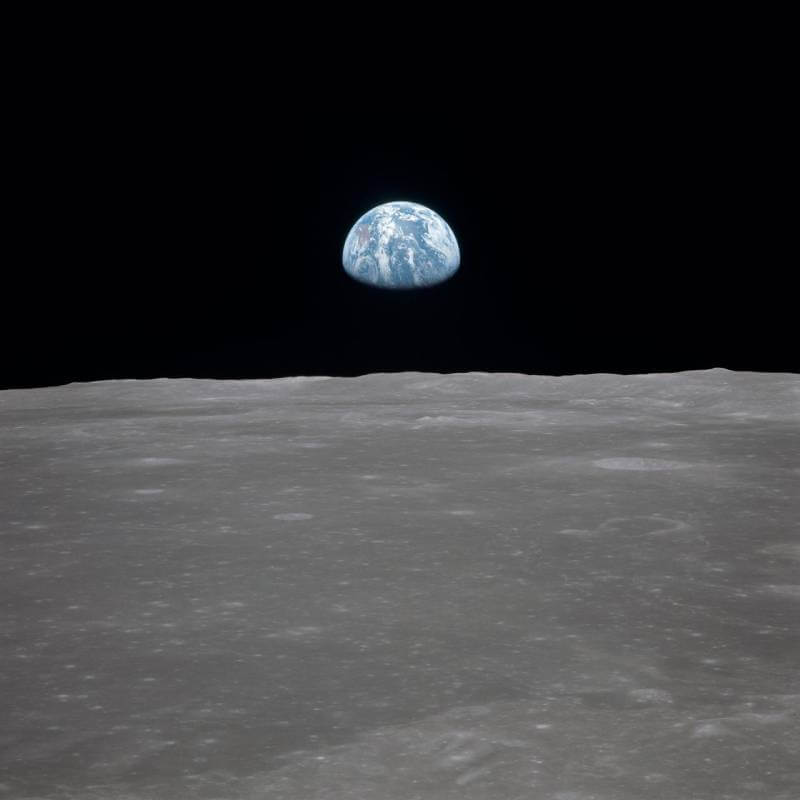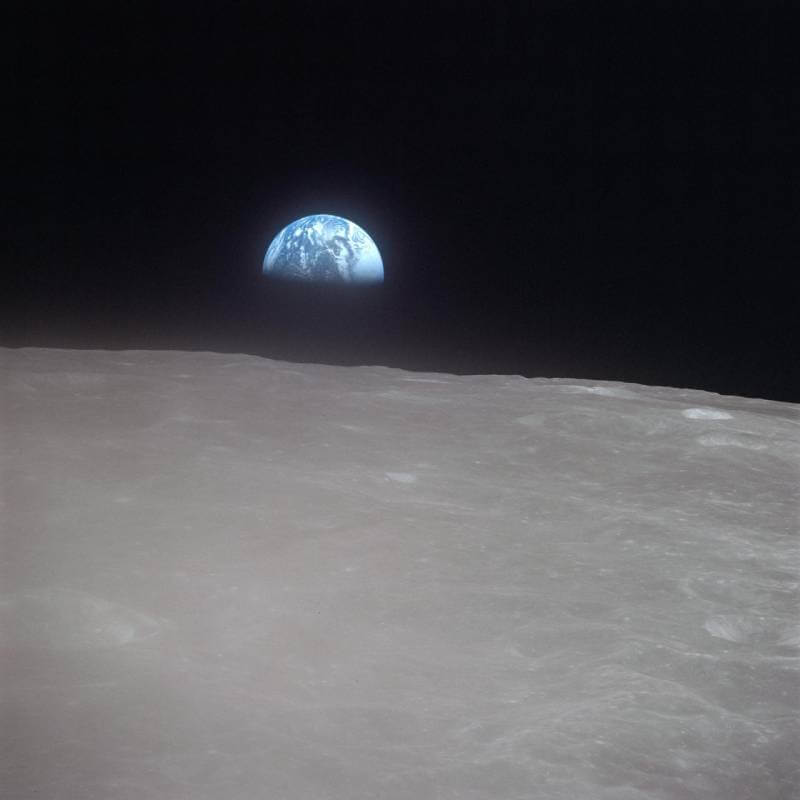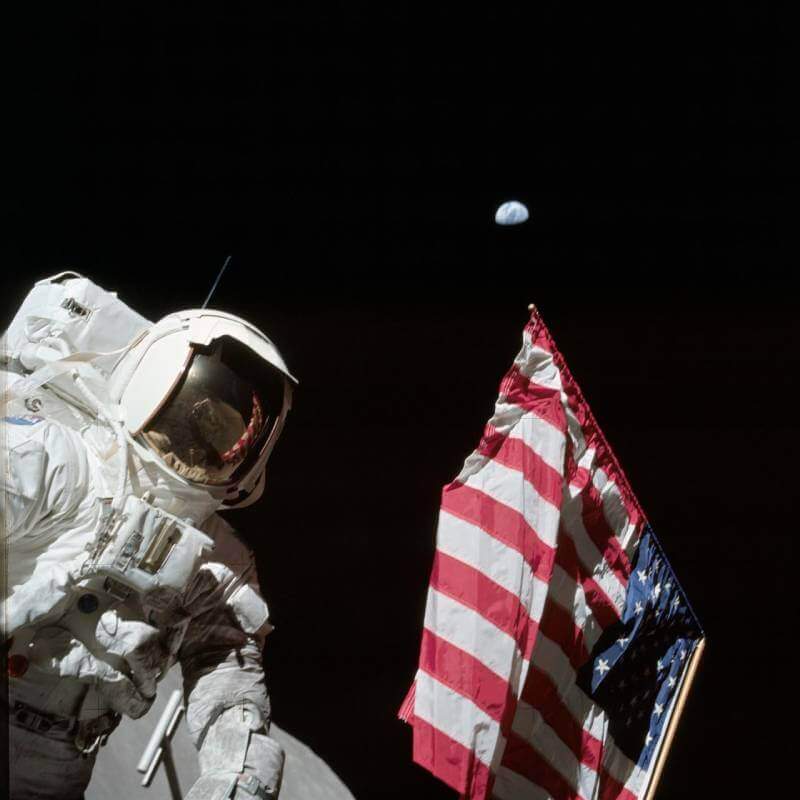Astronauts Harrison Schmitt and Gene Cernan landed in the Taurus-Littrow highlands on the lunar surface on December 11, 1972. During the moon landing for the Apollo 17 mission, Cernan snapped a picture of Schmitt posing next to the American flag with Earth in the backdrop. It’s one of the only images taken on the Moon showing an astronaut and the Earth in the same frame.
According to the official NASA timeline for the Apollo 17 mission, the astronauts deployed the flag and took the photo just over an hour into their first EVA, at 01:13:58 GMT. The official Apollo Lunar Surface Journal states the altitude of the Sun was approximately 16° during the event.
Since the Moon is “tidally locked” to our planet, it rotates and revolves around the Earth at the same rate. So, the side of the Moon we see from Earth never changes. The Earth spins in the lunar sky every 24 hours. Astronauts can see the Earth from the surface of the Moon, but it appears differently, depending on the observation position on the lunar surface and the phase of the Moon.
When positioned on the lunar equator, astronauts would see the Earth shining near the zenith and cycling through several phases, similar to how we view the Moon from Earth. Earth’s phases are complementary to the Moons phases.
When there’s a new Moon (from an Earth observation perspective), astronauts on the lunar surface see a full view of the Earth.
How Tilt and Rotation Speed Affect Viewing the Earth from the Moon
The orbit of the Moon has an incline of approximately 5.1° to the plane of the Earth’s orbit. This incline causes our planet to weave south and north of the ecliptic during each rotation around the Earth, just as the Moon does when observed from Earth.
It’s important to note the Moon speeds up in orbit when it gets closer to the Earth and slows when it gets further from our planet. This motion gives the appearance of the Moon rocking side-to-side during the month, exposing areas of the lunar surface beyond the western and eastern limbs.
The tilt of the Moon combined with the varying speed of its orbit around Earth causes our planet to trace a tiny ellipse in the lunar sky measuring 15° long during each revolution. When the Moon reaches an 85° north latitude, our world sinks below the lunar horizon for a few days every month.

Our planet moves along the ellipse at varying rates, mimicking the speeding up and slowing down of the Moon along its orbit. When viewed from the poles of the lunar surface, the Earth is close to the horizon, and our planet routinely rises and sets in a small area of the lunar sky during each orbital cycle.
The Earth’s brightness varies on the lunar surface, just as the Moons surface varies in brightness when viewed from our planet. A terrestrial crescent a day old will shine at an approximate magnitude of –6, but the Full Earth measures at –16, which is 15X brighter than a full Moon viewed from Earth.
During the new Moon, the lunar surface is covered in darkness. The full Earth offers nighttime illumination on the Moons surface that helps astronauts navigate their way across the lunar surface.
How Orbit & Conjunctions Affect Viewing the Earth from the Moon
Since the Earth is much larger than the Moon, it appears larger than the Moon in the lunar sky. From an astronaut’s perspective, when standing on the Moons surface, Earth’s diameter varies from 2° to 1.8° in visual diameter as the Moon moves from apogee (farthest approach) to perigee (closest approach) along its obit, which lasts 27.3-days.
When viewed from the Earth, every night, the Moon looks like it moves the width of a fist towards the east. It appears to shift from one constellation of the Zodiac to another. However, when viewing the Earth from the Moon, our planet remains in a small section of the lunar sky as the constellations pass by.

So, how do planetary alignments and conjunctions look from the lunar surface? Each month the Earth passes one planet after another in conjunction, just like the Moon does when viewed from Earth. However, there is a slight difference. The planets conjoin with the Earth, briefly pause, and then move on.
During the year, the orientation of our planet’s axis with respect to the Sun continually changes. The axis of the north pole tilts toward the Sun maximally around June 21, while the south pole axis has its opportunity to do so around December 21.
The optimal times for viewing the Earth’s polar regions from the lunar surface are during a new Moon and Earth appears full. This viewing opportunity occurs during the summer in the Northern and Southern hemispheres. During these times, the ends of our planet tip towards the Moon’s direction and have full sunlight for the best exposure from the lunar surface.
The View from the Moons South Pole & the Artemis Missions
NASA plans the upcoming Artemis missions to land around the rim of Shackleton Crater on the South pole of the lunar surface. NASA hopes to complete the Artemis moon-landing missions towards the end of the 2020s, with astronauts accompanied by robotic explorers on the mission.
The Artemis 1 mission will feature an uncrewed lunar loop around the Moon before returning to Earth. Artemis 2 will feature a crewed mission orbiting the lunar surface. Artemis 3 will be the first lunar landing mission since the end of the Apollo program. Artemis 3 is scheduled to launch in December 2025, however, technology and funding issues may cause delays to these launches.
In Closing
Astronauts can see the Earth from the lunar surface. However, the view they receive of our planet depends on several factors. The position of the observation site, the orbit around the Earth’s axis, and the tilt and rotation speed all play a role in how the Earth appears when viewed from the Moon.

